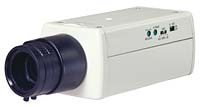Power Over Ethernet

Fortunately, there is a better, more cost-effective way to power network devices: Power over Ethernet, also known as IEEE 802.3af, or simply PoE.
Cost saving
With PoE, a commonly used cable on an existing LAN infrastructure is used to deliver data communications plus reliable, uninterrupted power from a power hub to an end point (powered device), eliminating the need for an electrical outlet to be nearby or for an electrician to run conduit. No changes are required to existing wiring or cabling systems. The current is transmitted over two of the four twisted pairs of wires in Category 3, 5, 5e or 6 cables to comply with safety standards and existing cable limitations. A mid-span device is typically added when upgrading an existing network, while an end-span Ethernet switch is normally installed for a new deployment.PoE is especially beneficial when cameras are needed on rooftops, ceilings and other difficult-to-access places where AC sockets are not available or pulling 110/220 VAC power lines is prohibitively expensive.
However, adapting Ethernet power saves installation cost no matter where the cameras are to be located. Consider the expense of conduits, outlet boxes and electrical wiring, plus the labor costs incurred from contracting electricians to install them, for fifty or more cameras throughout any given facility. PoE significantly reduces this cost, providing a higher return on investment with no compromise in power, network or video quality. Moreover, systems with fewer wires tend to be more reliable with a lower probability of an electrician inadvertently cutting power to a camera or other such accidents.
Another plus for PoE is that it makes it far easier to experiment and change a camera’s position. Independence from outlets allows fast, hassle-free relocating of cameras as needed to fine-tune coverage or to respond to new threats.
IT managers can rest assured that PoE does not degrade network performance nor does it decrease its reach. Also, devices that are non-compliant are blocked from receiving power, thus allowing the free mix of compatible and legacy devices on the network. Power sourcing equipment automatically detects the presence of a PoE-compatible device and injects power into the data cable and through its RJ45 jack. Some network devices that are not PoE-compatible can be made so with the installation of a picker or tap that removes current from the cable.
The IT manager will also appreciate the ability to turn on/off or reset any PoE-powered device without leaving their desk. This capability alone can save a company thousands of dollars annually in overhead costs for on-site service calls. And because PoE supports a point-to-multipoint power distribution network, it permits IT managers to use a single UPS at the network core to back up multiple scattered cameras on their network.
Power over Ethernet is an evolving and important technology. With the recent standardization of IEEE 802.3af now is an ideal time for end users to evaluate the potential PoE holds for video surveillance systems.
Looking for a reprint of this article?
From high-res PDFs to custom plaques, order your copy today!




